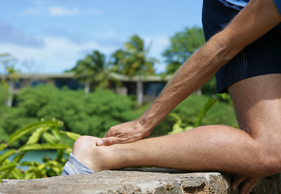According to ancient Greek mythology, the
great warrior Achilles was dipped in the sacred river Styx by his mother Thetis
so that he would be immortal, but she held him by his heel and it was not touched by the water, so his
heel remained mortal. During the Trojan War, Achilles was seemingly invincible,
killing many Trojan warriors, including Hector, Prince
of Troy, but Prince Paris of Troy shot
an arrow into Achilles’ heel and he died of the wound. As a result of this
legend, the expression ‘Achilles Heel’ came to mean a small but fatal
vulnerability, and the tendon connecting the heel to the calf became known as
the Achilles tendon.
Now
this is all rather ironic, since the Achilles is actually the thickest, strongest
tendon in our bodies, which it has to be in order to handle the strain of
connecting the heel to the powerful calf muscle. With each step we take, or hop
or jump, the calf contracts and pulls on the Achilles, which in turn provides
the elastic energy to push the foot downwards and allows us to move forwards or
upwards. Thus the Achilles carries our entire weight with each step, and
several times our weight when sprinting, pushing off or jumping.
TENDER TENDONS
It’s not surprising then that Achilles injuries are fairly common in
athletes, with the most common cause being overuse
due to a sudden, large increase in mileage. Overuse
also manifests itself in long-term strain on the tendon as well as a sudden
force being exerted on the tendon that results in a tear or rupture. Misalignment
is another common cause, with tight or weak leg muscles and misalignment of the
knee, hip or back placing undue strain on the Achilles, as can low arches and
uneven leg lengths, while women who wear high heels for long periods can end up
with shortened Achilles.
There are two common Achilles injuries:
?
Achilles
tendinosis (formerly called Achilles tendonitis) is a soreness that comes on
gradually and continues to worsen until treated. It often starts with stiffness
and ‘creaking’ when first getting out of bed, and lightly pinching the Achilles
with the forefinger and thumb will be sore. This is a common injury among middle
and long distance runners.
?
Achilles
tendon rupture is a partial or complete tear of the Achilles that comes on
suddenly, sometimes with a popping sound, and is debilitating. Partial and full
ruptures are most likely to occur in sports requiring sudden eccentric
stretching, such as sprinting, but can also occur in middle and long distance
runners.
ACHILLES FIX
Treatment for Achilles tendinosis includes
rest, icing and physio, followed by strengthening exercises. Treatment for an
Achilles rupture includes complete immobilisation, or surgery in the most
severe cases. Avoid anti-inflammatory and painkilling drugs, because Achilles
tendinosis is a degenerative injury rather than an inflammation and the drugs
will mask the problem, which will then likely get worse as you continue putting
force on the tendon.
To prevent an Achilles
injury, warm up properly with dynamic stretching (gentle calf raises, jogging,
jumps, hops or skipping) before working the tendon too hard. Do daily
strengthening with calf raises, starting slowly with just your body weight and
doing three sets of 10 to 15. When this can be done without pain, gradually
increase the number of repetitions and sets, and weight. Concentrate on a slow,
measured lowering, and be sure to go all the way down for a full stretch of the
Achilles.

